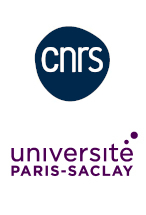
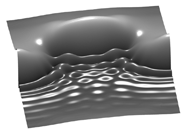
Dynamics of three-dimensional wavy liquid films
Collaborations : B. Scheid (ULB, Brussels), W. Rohlfs and Reinhold Kneer (RWTH Aachen)
Three-dimensional waves developing on the
free surface of falling liquid films intensify convective transport
in the adjacent phases, which influences the efficiency of multiphase
processes such as distillation. Here, we study the effect of these
surface waves on the velocity field and vice-versa by way of full
numerical simulations (VOF-CSF method).


Role of free convection on solute transport in a microfluidic channel
We studied the role of solutal free convection on the mixing of solutions with different concentrations in a horizontal microfluidic channel (lateral sizes in the range 5-500 µm). Using 2D and 3D numerical simulations along with asymptotic models, the solute transport is described by a succession of regimes depending on the Rayleigh number. Our work allows to predict conditions such that free convection cannot be neglected. We also provide a quantitative description of gravitational flows at the microfluidic scale.
J.B. Salmon, L. Soucasse, F. Doumenc Phys. Rev. Fluids 6,034501 (2021)
DOI: https://doi.org/10.1103/PhysRevFluids.6.034501

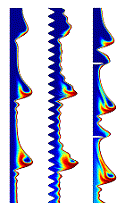
Scalar transport within a wavy falling liquid film
Collaborations : C. Ruyer-Quil (USMB, Chambéry), M. Ishimura et S. Mergui (FAST)
Within the ANR project wavyFILM, we study falling liquid films producing solitary surface waves due to interfacial instability.
Wall corrugations allow to enhance convective transport within these waves and thus to intensify heat/mass transfer across the liquid-gas
interface. The numerical simulations on the left, which were performed with the solver Gerris,
demonstrate the effect of different corrugation types on the field of a passive scalar governed by a convection-diffusion equation in the
liquid. In these cases, the Péclet number is high, so transport is convection dominated. Corrugations increase the averaged transfer
coefficient by 30%.
G. F. Dietze J. Fluid Mech. 859, 1098 (2019)


Heat transfer in karstic massifs
Karstic massifs are complex geological structures, containing networks of underground rivers, caves and conduits. Caves represent fragile ecosystems where biogeochemical processes largely depend on cave temperature. Caves also host unique environmental records whose interpretation closely depends on temperature as well. It is therefore important to identify the spatial and temporal evolution of the temperature field according to the massif morphology and to the climatic conditions. The figure on the left is a numerical simulation illustrating at a given time the thermal disturbance induced by the presence of a shallow cave (about ten meters below the surface) in a limestone massif.
B. Qaddah et al. Int. J. Therm. Sci. 177, (2022)
https://doi.org/10.1016/j.ijthermalsci.2022.107524

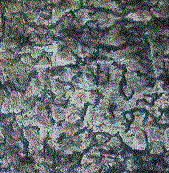
Vermiculation in caves
The picture on the left shows the rock wall of a cave with vermiculations (black worm-shaped in the picture). This phenomenon is frequently observed in underground environments and corresponds to the spontaneous formation of aggregates of materials initially present on the walls (clays, calcite, organic matter, etc). This phenomenon might become an issue in a painted cave because it can move the pigments and therefore damage the paintings. The purpose of this study is to understand the mechanisms responsible for the loss of cohesion of the material on the wall, with the aim of improving the preservation of prehistoric painted caves.
J. Martin et F. Doumenc EPL 138, 13001 (2022)
doi:10.1209/0295-5075/ac5cdc

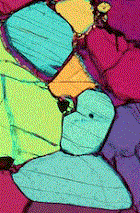
Polycrystal mechanics and mantle flow
When rocks in Earth's mantle deform, their constituent crystals take on a non-random crystal preferred orientation (CPO) that can be detected using seismic waves. To interpret such CPO in terms of mantle flow, we are developing a theory of polycrystal mechanics that can predict how individual crystals rotate during deformation. The figure shows a thinsection of a typical mantle rock viewed under polarized light.
Read more 

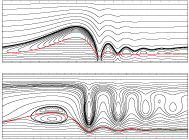
Falling liquid film in interaction with a gas
Heat and/or mass transfer between a liquid and gaseous phase can be realized with the help of falling liquid films. These flows are unstable
with respect to interfacial disturbances and, as a result, develop surface waves, which intensify the underlying transfer mechanisms.
The image on the left shows streamlines within a liquid film and its surrounding gaseous atmosphere (top: counter-current, fixed reference frame; bottom: co-current, moving reference frame).
These representations evince the occurrence of several wave-induced vortices.
G. F. Dietze, C. Ruyer-Quil J. Fluid Mech. 722, 348 (2013)


Dynamics of free subduction
Subduction, the gravity-driven sinking of oceanic lithosphere into
the Earth’s mantle, is a major component of plate
tectonics. We are building three-dimensional flow models
of subduction to understand the factors that control the diverse
morphologies of subducted plates revealed by seismic tomography,
focussing on the interaction of the plates with
the phase-change boundary at 660 km depth in the mantle. The image
shows three possible plate morphologies depending
on the ratio of the viscosity of the plate itself to that of the
surrounding mantle.
Read more 




